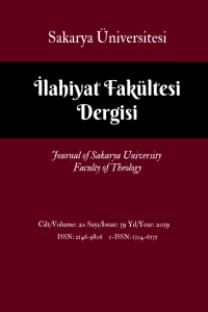AYINTÂBÎ’NİN TERCÜME‐İ TİBYÂN TEFSİRİNİN MUHTEVA VE METOD BAKIMINDAN DEĞERLENDİRİLMESİ
Tercüme-i Tibyân Tefsiri, Padişah IV. Mehmed’in isteği üzerine Tefsîrî Mehmed Efendi lakabıyla meşhur, Muhammed b. Hamza el-Ayıntâbî ed-Debbağ tarafından yazılmıştır. Padişah, Ayıntâbî’den Arapça dil kaidelerine uygun olarak nâzil olan Kur’ân-ı Kerim’i Türkçe’ye çevirerek, onun manasındaki gizlilikleri, eşsiz hakikatleri, istiare ve ince misalleri açıklamasını istemiştir. Ayıntâbî de tefsirini yazdıktan sonra padişaha ve halkın istifadesine sunmuştur. Bazı bibliyografya kaynaklarında Tercüme-i Tibyân tefsirinin Şeyhülislam Debbağzâde Muhammed b. Mahmud’un eserleri arasında kaydedilmesine rağmen, bu tefsirin, Muhammed b. Hamza el-Ayıntâbî ed-Debbağ’a ait olan Tercüme-i Tibyântefsiri olduğunu tespit edilmiştir. Ayıntâbî’nin tefsirini, Beğavî, Râzî ve Beydâvî’nin tefsirlerinden alıntılarla yazdığı, gerekli gördüğü yerlerde bu kaynaklardan başka eserlerden de alıntı yaptığı, bu tefsirin, Hızır b. Abdurrahman elEzdi’nin Tibyân tefsirinin tercümesi olmadığı tespit edilmiştir. Tefsirin kaynakları, metodu ve muhtevası hakkında bilgi vererek Ayıntâbî’nin yazmış olduğu bu tefsir ve müfessiri hakkındaki bilgiler tashih edilmiş, aynı zamanda Osmanlı Dönemi Tefsir Faaliyetleri içerisindeki doğru ve hak ettiği yeri alması hedeflenmiştir.
The Evaluation Of Ayntâbi’s Tercüme-i Tibyân Commentary With Regard To Content And Method
The Commentary of Terceme-i Tibyan was written by Muhammed b. Hamza el-Ayntabi ed-Debbağ, who was also known as Tefsîrî Mehmet Efendi, upon the will of Sultan IV. Mehmed. The Sultan wanted Ayıntâbî to translate Koran, the original of which is in Arabic, into Turkish and explain the secrets, unique truths, metaphors and graceful examples of it. After Ayntabi wrote the Commentary, he presented it to the Sultan and the the people. We realized that some of the commentaries of Tercüme-i Tibyân in our library were recorded in the name of Şeyhülislam Debbağzâde Muhammed b. Mahmud. We also came across that in some bibliography sources, the commentary of Tercüme-i Tibyân was recorded among the Works of Şeyhülislam Debbağzâde Muhammed b. Mahmud. We determined that the commentaries of Tercüme-i Tibyân which was recorded in the name of Şeyhülislam Debbağzâde Muhammed b. Mahmud in our libraries was actually the commentary of Tercüme-i Tibyân which belonged to Muhammed b. Hamza el-Ayıntâbî ed-Debbağ. We determined that in the bibliography sources, this commentary was recorded among the works of Şeyhülislam Debbağzâde Muhammed b. Mahmud by mistake, in fact its author was Muhammed b. Hamza el-Ayıntâbî ed-Debbağ. Ayntabi wrote the commentary using the quotations from Begavi’s, Razi’s and Beydavi’s commentaries. He, when needed, used some other quotations, too. We also identified that this commentary wasn’t the translation of Hızır b. Abdurrahman el-Ezdi’s Tibyân commentary. In our study we evaluated resources of the commentary, the content and the method which Ayntabi followed while writing the commentary of Tercüme-i Tibyân by giving information. The information about the writer of Tercüme-i Tibyân and its interpreter was clarified. Besides, in our study we enlightened the position of this commentary /Tercüme-i Tibyân in the Commentary Activities in the Ottoman Age.
